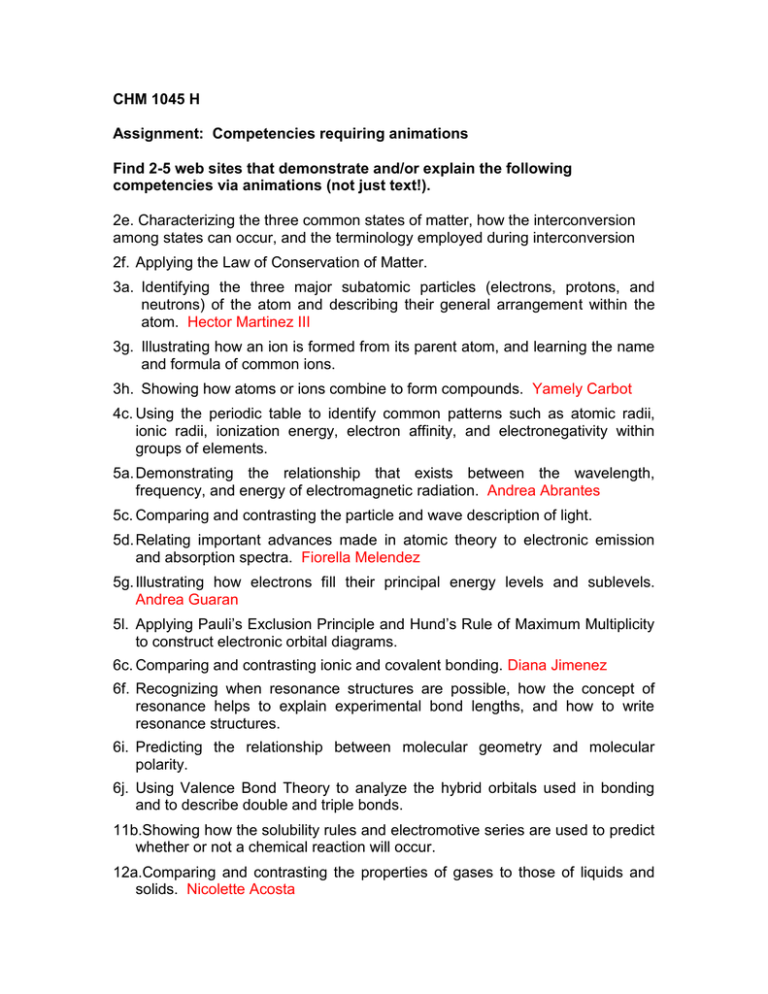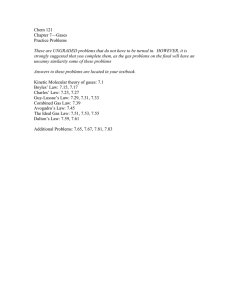CHM 1045 H Assignment: Competencies requiring animations
advertisement

CHM 1045 H Assignment: Competencies requiring animations Find 2-5 web sites that demonstrate and/or explain the following competencies via animations (not just text!). 2e. Characterizing the three common states of matter, how the interconversion among states can occur, and the terminology employed during interconversion 2f. Applying the Law of Conservation of Matter. 3a. Identifying the three major subatomic particles (electrons, protons, and neutrons) of the atom and describing their general arrangement within the atom. Hector Martinez III 3g. Illustrating how an ion is formed from its parent atom, and learning the name and formula of common ions. 3h. Showing how atoms or ions combine to form compounds. Yamely Carbot 4c. Using the periodic table to identify common patterns such as atomic radii, ionic radii, ionization energy, electron affinity, and electronegativity within groups of elements. 5a. Demonstrating the relationship that exists between the wavelength, frequency, and energy of electromagnetic radiation. Andrea Abrantes 5c. Comparing and contrasting the particle and wave description of light. 5d. Relating important advances made in atomic theory to electronic emission and absorption spectra. Fiorella Melendez 5g. Illustrating how electrons fill their principal energy levels and sublevels. Andrea Guaran 5l. Applying Pauli’s Exclusion Principle and Hund’s Rule of Maximum Multiplicity to construct electronic orbital diagrams. 6c. Comparing and contrasting ionic and covalent bonding. Diana Jimenez 6f. Recognizing when resonance structures are possible, how the concept of resonance helps to explain experimental bond lengths, and how to write resonance structures. 6i. Predicting the relationship between molecular geometry and molecular polarity. 6j. Using Valence Bond Theory to analyze the hybrid orbitals used in bonding and to describe double and triple bonds. 11b.Showing how the solubility rules and electromotive series are used to predict whether or not a chemical reaction will occur. 12a.Comparing and contrasting the properties of gases to those of liquids and solids. Nicolette Acosta 12b.Determining the qualitative and quantitative relationship among pressure, volume, temperature, and amount of gas (Boyle’s Law, Charles’ Law, Avogadro’s Law, and Combined Gas Laws). 12f.Describing how mixtures of gases behave and how Dalton’s Law is used to solve problems involving a mixture of gases. 12g.Using the kinetic-molecular theory of gases and showing and how this theory is consistent with the observed gas laws. 12h.Describing molecular motion, diffusion, and effusion of gases. Susana Villate 12i.Identifying the factors responsible for making gases behave either more or less ideally. 13a.Comparing and contrasting the various acid-base theories (Arrhenius, Brønsted-Lowry, and Lewis). 13b.Giving various properties of acids and bases. 13d.Understanding the relationship between acid and base conjugate pairs by being able to correctly identify acid-base conjugate pairs in an acid-base reaction. 13e.Predicting strengths of acids and bases.


